In this ever-changing world, we have an app for everything. The global market for app modernization is also expected to reach $50,440 million by 2028. So, developing dynamic apps that cut through the noise has become necessary for enterprises to succeed.
However, many businesses still have an application portfolio that relies on traditional monolithic architecture. Application modernization with advanced tools and technologies presents an opportunity to transform legacy software to keep an enterprise agile. Also, it helps businesses boost operational efficiency, lower production costs, and enhance the overall customer experience.
But, 93% of IT leaders face challenges while modernizing their apps. So, application modernization only makes sense when you do it right and know how to avoid the pitfalls. This blog serves as a concise guide on application modernization, covering its meaning, benefits, challenges, and best practices.
What is application modernization?
Application modernization is mostly about updating an organization’s existing apps to a cloud-first model—sometimes called legacy modernization. It may involve migrating those apps to a public, private, or hybrid cloud if an organization uses on-premises apps.
Here, older applications are updated with newer approaches to computing, including more contemporary frameworks, languages, and application architectures. The modernization of legacy applications enables enterprises to improve an existing system’s overall efficiency, security, and structural integrity rather than replacing it entirely.
A Definitive Guide to Legacy App Modernization Using Microservices
When to consider application modernization?
Enterprises are focusing more on modernizing applications in the wake of the pandemic to drive innovation and integrate new processes. However, they need the relevant infrastructure to support them in achieving modernization goals.
A robust strategy for modernizing apps allows organizations to go to market faster by reducing maintenance costs, enhancing their accessibility to the latest data, and updating existing operational processes. As a result, the profits get manifold, and customer experience is also improved.
Here are some reasons to kickstart your app transformation journey –
1. You want to improve app functionalities
Application modernization is mostly about updating an organization’s existing apps to a cloud-first model—sometimes called legacy modernization. It may involve migrating those apps to a public, private, or hybrid cloud if an organization uses on-premises apps.
Constantly updating your app as per the taste of users is the key to staying competitive and fulfilling users’ requirements. To achieve this goal, you must add new features and enhance security with every app update. However, new features might not always be possible with outdated technologies or systems.
Subsequently, there is no need to invest in third-party integrations while adding a new feature or functionality.
2. You want to reduce costs
Typically, the on-premise app development and maintenance is costlier or overburdened by tech debt. In addition to hiring people to run them, you also have to pay for licensing.
Initially, migrating to the latest technologies and architectures may look costlier. But ultimately, you can save on the costs of integrating new technologies.
Including this, you can replace legacy applications with feature-rich open-source software with frequent commercial support and no license costs.
3. You want to reduce human dependency
Automation of multiple tasks helps you reduce the repetition of activities or redundancy. In addition, you can ensure minimal dependency on your workforce so that they can become more productive and efficient.
4. You want to increase agility
Deploying new versions of monolithic apps is quite complex. But you can ensure rapid and continuous delivery of apps by using advanced container orchestration platforms like Kubernetes and adopting DevOps best practices. Additionally, you can update separate parts of your app when you refactor by breaking monolithic apps into deployable microservices.
Myths of application modernization
Companies have started recognizing software as a strategic corporate asset to combat cutthroat competition. Today, modernization is no longer solely the concern of software-centric organizations. The approach also spans multiple functions, including sales, HR, and core IT, to name just a few.
Here are a few myths that prevent organizations from recognizing the need to modernize their applications and hinder their growth in the long run –
1. Modernizing the operating model is costly
Enterprises need to be more agile and change their app development portfolio as they try to transform their business models or align with customers’ needs. However, organizations often struggle with finances due to the build-up of technical debt, maintenance costs, and operating expenses.
Paying the excessive technical debt may look like eating your future earnings as you already bear labor and licensing expenses. But what if you take the resources for maintaining those applications and focus them on incrementally rehosting? Or replatform them using best practices for the modernization of applications? By reallocating those resources, you are continuously driving innovation and efficiency.
2. Application modernization needs a skilled in-house software team
Many businesses often believe that professionals with in-depth knowledge and experience in software development are prerequisites to modernize applications. But this belief is not entirely true.
You can hire an external software vendor or a remote software development team to handle IT backlogs. Also, you can opt for a combination of low-code services and platforms. With low-code platforms, you can build and update apps much faster, enabling developers to share functionalities with stakeholders within a few hours or days.
In addition, you can integrate Rapid Application Development (RAD) to facilitate your development team to shift their focus on solving key performance issues rather than handling error-some and mundane technical requirements. As a result, the risk of failure gets reduced to a great extent.
3. Changing the app user interface is modernization
Revamping the user interface is quite popular as it helps you have an app that looks appealing and makes navigation easier. But most applications have complex workflows; a basic UI fix doesn’t necessarily improve the user experience.
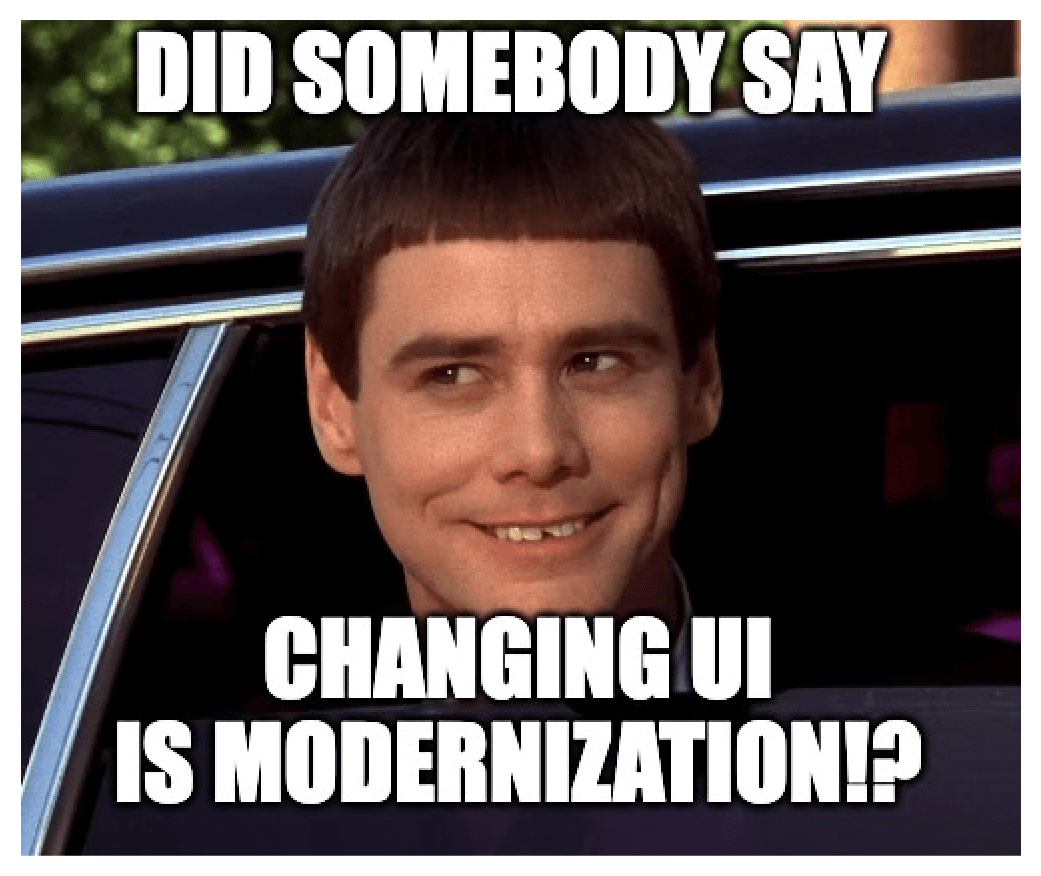
UI is pertinent to only the usability component of UX, while other components, like extensibility and accessibility, largely depend on the application’s tech composition. So modernization initiatives would also need intervention at the tech layer to generate any meaningful impact at the app experience levels.
Benefits of application modernization
Modernizing applications benefit you to stay flexible and competitive, and you can also bankroll key technologies such as artificial intelligence, machine learning, and cloud computing. Apart from this, it is the perfect strategy to enhance customer engagement and extend your user base.
Let’s understand why every enterprise should consider modernizing its legacy applications –
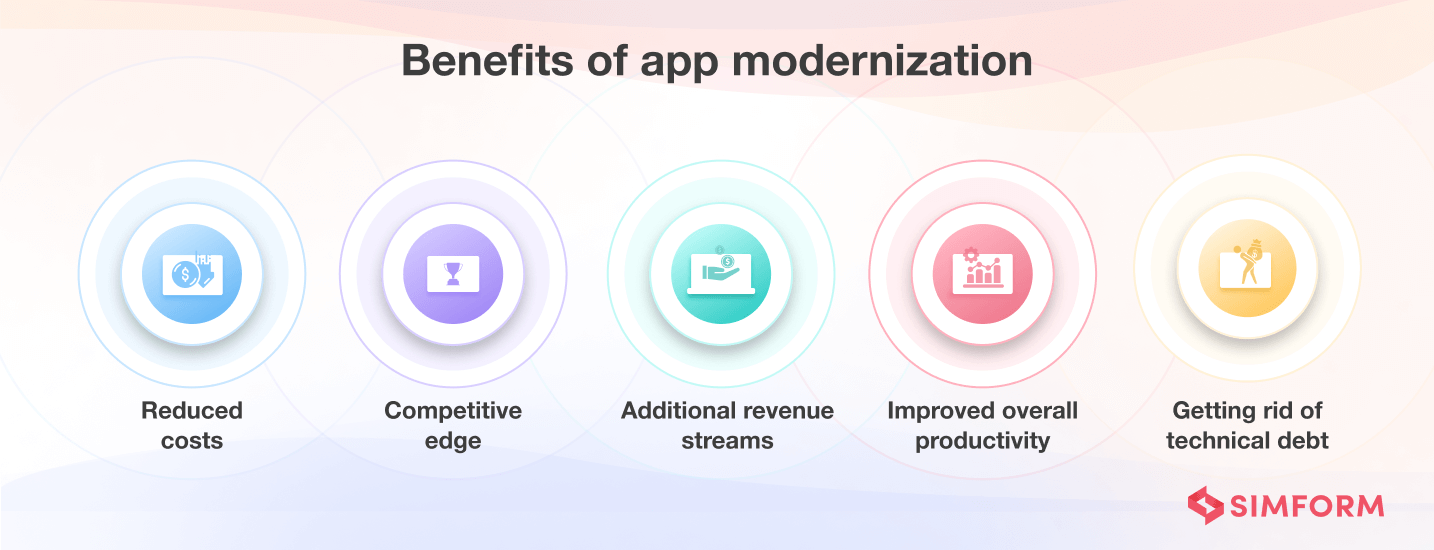
1. Getting rid of technical debt
The outdated system contains various issues like bugs, application maintenance costs, and lack of scalability. As a result, businesses have to assign 10% to 20% of their product development budget to resolving the issues related to tech debt.
The modernization approach eliminates the need to replace your existing systems altogether. Subsequently, you do not need to spend a fortune to maintain an outdated code and have a more robust and healthy application.
2. Improved overall productivity
Being equipped with advanced tools and technologies aligned with the prevalent trends makes development and admin teams more productive. Also, it becomes easier to automate repetitive tasks, educate fresh recruits, reduce monotony in work and improve employee productivity to a great extent.
3. Additional revenue streams
The addition of new features and services satisfies customers’ needs and lets you emerge as a winner on the business battlefield. But as legacy systems are not that flexible, relevant challenges become a herculean task.
With application remodeling, adding new features and services becomes easier, leading to an improved customer experience and increased profits. The chances of customer referrals also increase, which eventually helps generate more leads.
4. Competitive edge
The outdated legacy systems are often incapable of satisfying the demands of modern customers. Such a situation can drive them toward your competitor’s application with better features.
It is naturally advantageous to embrace modernization while your competitors might still consider adopting it. Moreover, it enables you to incorporate cutting-edge platforms and technologies to outpace the market competition.
You can also access real-time data analytics collected from different geographies, which isn’t generally possible with legacy applications.
5. Reduced costs
By migrating to the cloud, you do not need to sprint money on a separate on-site data center, which could have increased your overhead. Besides, cloud migration can reduce the costs of operating your old legacy. A cloud database offers a pay-as-you-go pricing model where you only have to pay for the service.
What are the Application Modernization Challenges?
Modern-day tech leaders need to deal with a complex app scenario that includes different technologies, infrastructure, and frameworks overlapping with existing business goals and business processes. Then there are challenges related to cultural change in the IT landscape, app development budget, and upgradation of development skills.
Here are some more application modernization challenges you may face while determining the flow of the modernization process –
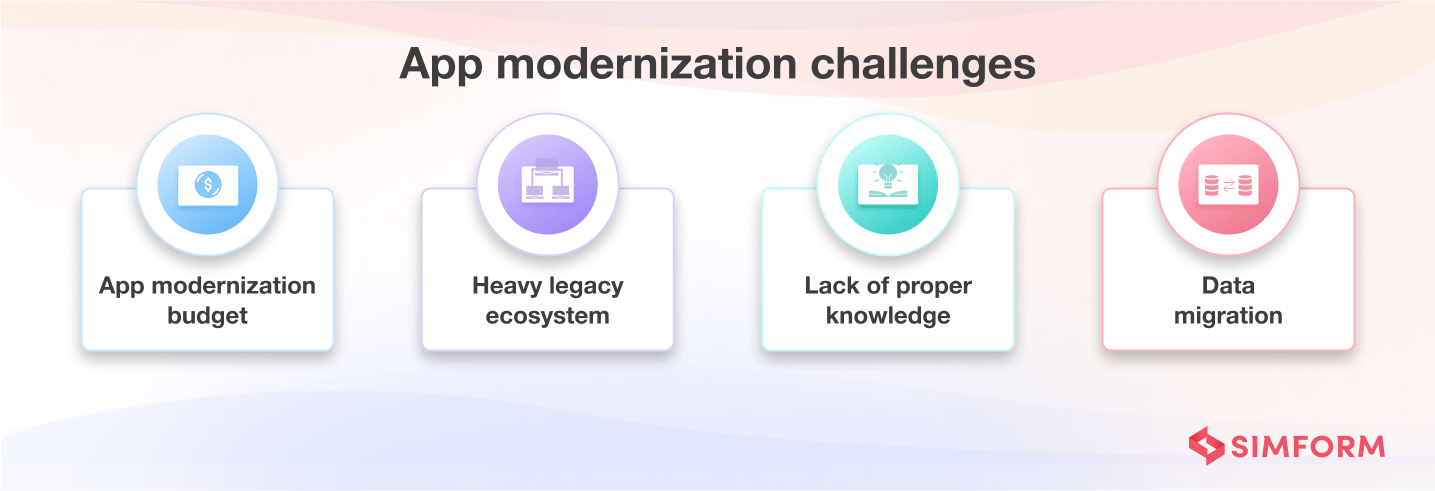
1. Application modernization budget
Cost is the foremost constraint that prevents many organizations from tailoring their apps to modern world demands. Assessing the accurate budget to run the legacy applications in the upgraded version is not child’s play. The costs of cloud platforms and infrastructure are also high and might vary.
To make the entire process budget-friendly, you must separate the monolith legacy application into components. Then, you can hire a development team with full-stack expertise to help you develop the desired combinations. Keep your modernization budget adjustable to unforeseen costs like scaling the workforce and onboarding newer technologies.
2. Heavy legacy ecosystem
Modernizing the entire legacy ecosystem has a significant impact on business. Moreover, the upstream and downstream applications would still be in legacy technologies, along with multiple protocols and file formats. Therefore bringing them to a contemporary platform all at once is not a brilliant idea.
In such a case, you should modernize the critical applications first and then handle the rest. Also, you can set up some tools and design applications to support legacy practices so that the current business flow stays unaffected throughout the transition period.
3. Lack of proper knowledge
Lack of suitable knowledge is one of the prime roadblocks to the modernization of applications. There are a few reasons behind it which are as follows –
- Original app developers are no longer in the organization or working on the same project
- Tech documentation is missing or irrelevant
- Third-party resources or libraries are unavailable
- The source code is corrected heavily
One alternative approach is to go through the code and manually pick a new function, which might be time-consuming because of the obsolete or nonexistent code.
4. Data migration
Legacy ecosystems contain a lot of databases, including business-oriented data in the form of gigabytes, terabytes, or petabytes. Moreover, legacy systems use the older EBCDIC encoding, while modern systems operate on ASCII-based encodings. Because of all such things, the data migration process might look complicated to you.
There are a few tools in the market to take care of code differences and some ETL plugins that help in easy data migration. However, you’d need a framework to handle data files with non-contemporary encoding. In addition to this, you can migrate system VSAM files to NoSQL or SQL databases.
One of our esteemed clients, a fast-growing UK-based fintech platform, wanted to modernize its legacy frontend with a dynamic component-based architecture to ensure a better user experience. We modernized the legacy app frontend and migrated terabytes of users’ data by implementing data migration and cloud migration strategies.
How UK's Emerging FinTech Platform Harnessed the Power of Modernization?
Application modernization approaches
An efficient modernization strategy can minimize the resources needed to run an application, improve the dependability of deployments, and enhance uptime resiliency. But before making the selection, you should look at some widely-used options to modernize the applications –
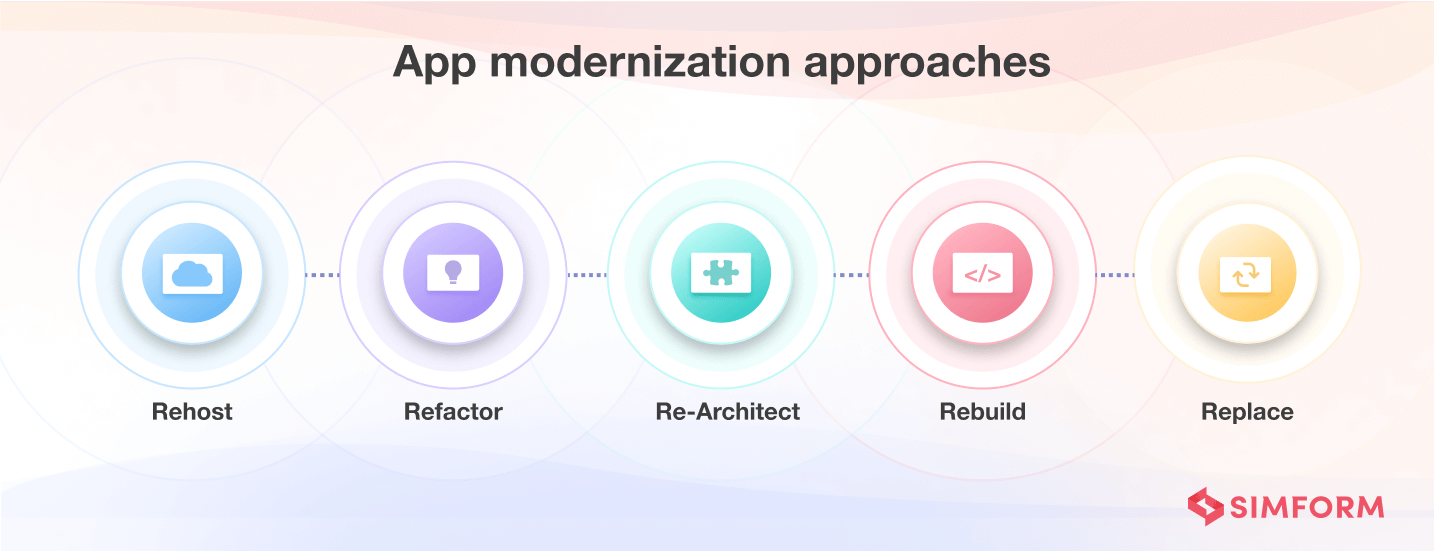
1. Rehost
The rehost approach, also known as the Lift & Shift concept, entails shifting key app resources from an on-premise data center to a cloud database. Here the app codebase remains the same; the infrastructure is migrated to cloud infrastructure-as-a-service (IaaS), including cloud-based storage and network resources.
2. Refactor
Refactoring expects you to be cloud-friendly in the booming digital era. It includes app modification and part of the code to get the advantages of a public cloud. Furthermore, refactoring lets you develop independent services to make app functionalities usable.
3. Re-Architect
Here, monolithic apps are re-architected as per the microservices model, divided into a cluster of services, and put in their containers. Consequently, you get different benefits, like faster time to market, reduced costs, business agility, and better customer experience.
4. Rebuild
Rebuild is almost similar to the re-architect approach, but the difference here is that you are starting from scratch instead of remodeling. In this approach, you can rewrite a cloud-based app that eventually assists you in boosting innovation, reducing overall development costs, and harnessing technological advancements.
5. Replace
If your legacy app has some functionality that is still useful, you can replace it with a more elegant cloud-based solution. The idea is to revamp the old monolithic application as per modern microservices architecture. This may include replacing proprietary plugins, outdated technologies, or tools with industry-standard and open-source ones.
Application modernization best practices
The demands of the modern world call for consistently updated applications to fulfill the needs of integration, stability, data security, and scalability in a cloud-first environment.
Follow these application modernization best practices to embark on the enterprise application modernization journey:
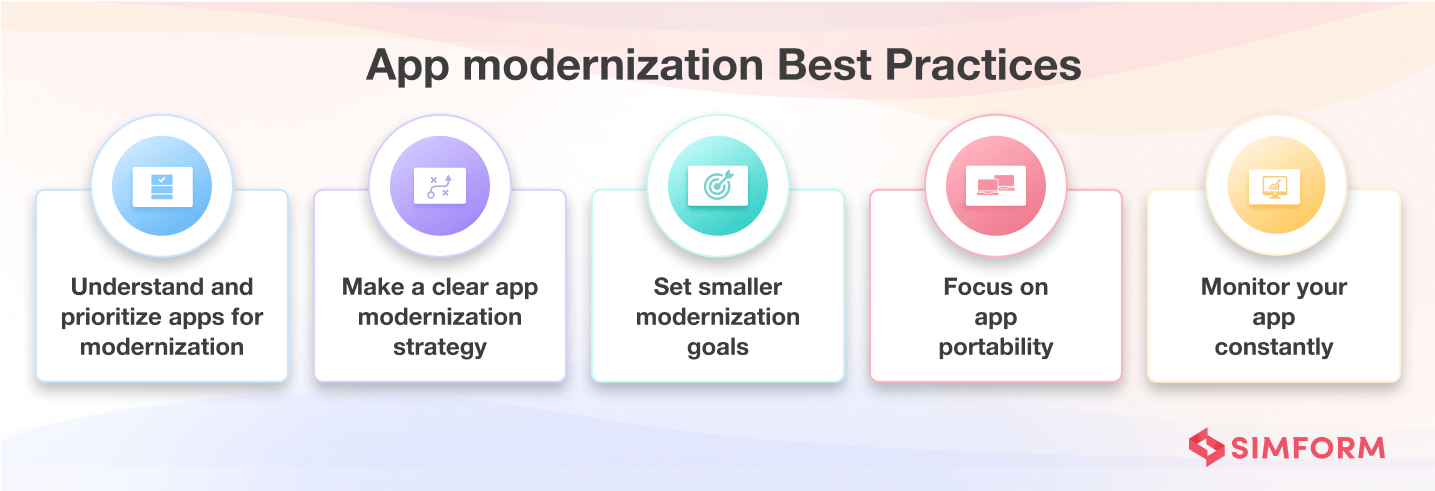
1. Understand and prioritize apps for modernization
First, you must conduct in-depth research about an app and its dependencies. You can start by understanding the app’s performance in the current environment and its integration with other systems within the ecosystem, and how it operates under different conditions.
2. Set smaller modernization goals
Mapping out primary goals in advance may become pointless, eventually ending with incomplete or late projects. Instead, focusing more on reducing the cycle time and iterating towards smaller goals holds a much higher likelihood of success.
When planning for major milestones, the focus should be on the many small steps between them. By fragmenting the project goals into subgoals, you can efficiently respond to changing needs, adjust your long-term plans, and reduce engineering risk.
3. Focus on app portability
Many modernization projects fail to unlock their full potential as development teams merely focus on migrating to a new hosting model rather than increasing application portability.
This is a mistake, as portability matters a lot for any application. By prioritizing portability, your apps can be future-ready against rapid business changes. Also, you can migrate quickly to a new environment without significant overhauls.
4. Monitor your app constantly
Continuously monitoring different aspects of an application with its logs, metrics, traces, and performance data can be quite advantageous. However, getting better visibility into multi-cloud costs across different teams can be complex. Moreover, you should fetch consumption data from other clouds to view charges, security vulnerabilities, and platform availability.
Configuration of various open-source tools like Fluentd, Jaeger, Elastic, Grafana, etc., helps create a comprehensive dashboard for application monitoring. Moreover, a DevOps solution improves cloud observability and containerized apps.
Strategy for App Modernization on the AWS Cloud
Don’t miss out on application modernization when Simform is at the wheel!
Modernizing your application is not an ultimate solution but an ongoing cycle as new technological trends and customer requirements keep emerging. If you are looking for a reputed partner to make your legacy applications more agile and cloud-efficient, an experienced app development company like Simform can be the perfect option.
Our experts can help you build a strategic roadmap to integrate an ideal modernization strategy by analyzing your business needs. Schedule a 30 minutes free consultation to modernize your legacy apps with next-gen tools and technologies.